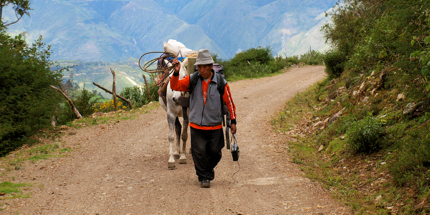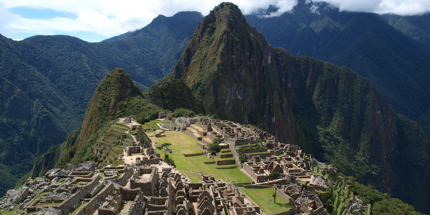Machu Picchu: the alternative route
He may still be up there. Darren Loucaides slogs his way to the Lost City of the Incas via the Salkantay trek.
I’m not sure if it’s the rain, altitude or lack of sleep, but just climbing the foot of Mount Salkantay is proving a struggle. We hiked all of yesterday to reach the green, misty plain of Soraypampa, which sits under the shadow of the mountains, and still a restless night followed.
While my tent withstood the torrential overnight downpour, conditions had little improved when we continued at daybreak. Now, as I gaze breathlessly at the sheer path that zigzags towards the loftiest point of the trek at 4,600 metres (15,092 ft), I wonder if I’ll survive the whole journey to Machu Picchu.
The five-day Salkantay trek to South America’s greatest landmark is becoming the main alternative to the classic Inca Trail. Traversing hill, mountain and jungle over 90 km (56 miles), it’s far less crowded, and no wonder: this is a more challenging slog. The toughest day extends beyond 10 hours of hiking. You don’t need to be an athlete or gym zealot to survive, but if your idea of exercise is a brisk walk to the pub, best stick to the Inca Trail.
I start to grasp what I’ve let myself in for by lunchtime of the first day. Our Cusqueño guide, Ruben (who is inexplicably rotund given his four treks per month during high season), cheerfully assures us, his so-called “new family”, that today is relatively easy. But while most of the journey from the mountain village of Mollepata has been on flat, dusty roads that wrap around the green hills rising to mountains, the few “shortcuts” that cut steeply through dense vegetation have taken it out of me.
 A local and his donkey ascend the Salkantay route
A local and his donkey ascend the Salkantay routeAndrea Alemany
We haven’t exactly been going fast, either. Ruben regularly pauses to identify a particular plant and explain its applications since Inca times, like the elegant trumpet-shaped floripondio, a sacred plant with formidable mind-altering properties. But by the time I spot our Soraypampa campsite at the foot of Mount Umantay, where dew trickles down looming rock faces and fog drifts in, I feel like rejoicing.
The next day, after hiking three hours alongside the thrashing Rio Blanco (White River), we begin the difficult ascent up Salkantay Pass. The rain has stopped, allowing me to shed my plastic poncho, but the altitude makes me feel like I’ve just chain-smoked 20 cigarettes. Finally, as we reach the shoulder of the mountain, our hard work is rewarded by an awe-inspiring view of the ice-glazed peak, shining brilliant white in the midday sun. There’s plenty more to come, but this is the pinnacle of the trek.
“Well done, my champions!” exclaims Ruben. Gathering us into a circle, he explains that the Incas worshipped the nearby mountains of Umantay, Salkantay and Machu Picchu as gods and made pilgrimages to each of them. In native Quechuan, he leads us in a thanksgiving prayer to each mountain apu (god): “Urpinta Sonko Apu Salkantay.” We blow on coca leafs and bury them under stones.
 Salkantay is the highest mountain in the Willkapampa range
Salkantay is the highest mountain in the Willkapampa rangeAndrea Alemany
Our descent takes us through verdant slopes and past an old Inca Trail. We camp for the night on the edge of the jungle. Day three is a more relenting hike along the fringe of the cloud forest, past fields of banana, avocado and coffee. We stop to pick sweet granadillas (passion fruit) from the trees. The noise of the river booming through the dramatic Valley of Santa Teresa rises from far below.
We sooth our limbs during a much-needed afternoon at the Santa Teresa hot springs before the penultimate day’s hike along an old British railway line to the colourful journey’s end town of Aguascalientes, where pastel-coloured buildings pile against rugged hills. On arrival, I collapse onto the hotel bed and fall immediately to a deep slumber, exhausted. Then there’s still Machu Picchu to come.
 Peru's greatest landmark is worth five days of trekking
Peru's greatest landmark is worth five days of trekkingAndrea Alemany
It’s best to begin the final, hour-long climb up the ancient Inca steps before dawn, as they become flooded with as many as 2,000 tourists each day. At the summit, we certainly feel that we’ve earned our tickets more than those arriving by the fleet of buses from Aguascalientes. But following such an immense journey, is it all worth it? Arranged carefully over the peaks of Machu Picchu and Huayna Picchu, which are like upturned thumbs nudging the heavens, the grey stone ruins are beguiling. After taking a photo at the highest point, I have to lie beneath one of the thatched roofs out of the sun.
“Are you okay?” a tour guide asks.
“I’ve just finished Salkantay - 90 kilometres,” I mutter, unable to move.
The guide repeats this in Japanese to his group. They gasp at each other and then start taking pictures of me as if witnessing a miracle. On my descent, I observe my own marvel: a rainbow arcing over the lost city of the Incas. Yes, I think it was worth it.
IDEAL FOR…
Anyone looking for a more challenging trek than the relatively easy Inca Trail and ideal for those who want to avoid swathes of tourists.
WORTH THE PRICE?
Prices range between $250 and $500. To budget travellers this may seem a little steep, but bear in mind that the price typically includes camping equipment, meals and a guide for five days. Entrance to Machu Picchu and a train back to Cusco are also incorporated. High-end options are now available, with a handful of luxury mountain lodges opening along the route.
ROOM FOR IMPROVEMENT
Two members of my group found the trek too difficult and had to use horses for part of the way at extra cost. Salkantay is not suitable for everyone, and some tour agents need to make customers more aware of this.
TIPS
Make sure to bring a decent sleeping bag, hiking boots, a water-proof coat (and plastic poncho), torch and some emergency supplies of chocolate for when energy’s running low.
RATING
5/5
DETAILS:
There are dozens of companies operating out of Cusco, all offering more or less the same route. This tour was booked through a local agent, Amadcus (www.amadcus.com). Another worth considering is Bioandean (www.bioandeanexpeditions.com).
Do you have any Feedback about this page?
© 2025 Columbus Travel Media Ltd. All rights reserved. No part of this site may be reproduced without our written permission, click here for information on Columbus Content Solutions.









 You know where
You know where